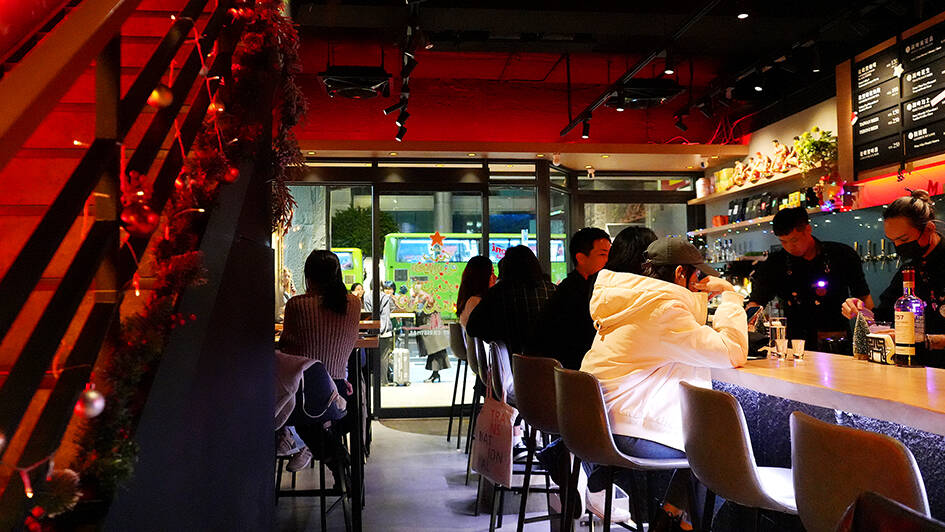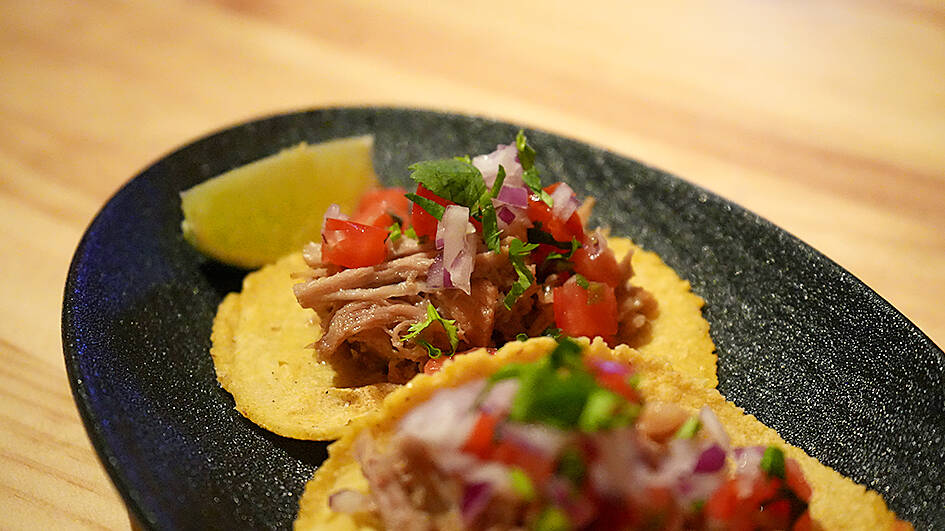Some say there are few greater pleasures in life than gossip over a margarita and a bowl of chips and guac on a Friday night. I concur, and the end of the week sees me at Nowhere Taipei Mexican Bistro (Nowhere Taipei 墨西哥餐酒館) in Datong District (大同).
Dim lighting, cool music, cooler crowd, it’s an obvious first date choice downstairs, but a rowdier party spot upstairs with football on the big screen, bustling tables and a sweet French Bulldog lapping up the attention.
This place only opened in May, but it’s booked and busy; it’s rare to find an inviting cocktail spot in the seedier side of town beside Taipei Main Station.

Photo: Hollie Younger
A bar first and foremost, the cocktails range from Japanese-style yuzu and gin to Sangria to local-style winter melon concoctions. They also serve coffee in the mornings. The menu is mostly Mexican but, as with many a Taiwanese bar, they throw in some spaghetti and chicken nuggets for good measure. This bar is not Nowhere, it’s trying to be everywhere, and sometimes direction is key to delivery.
Why did you decide to serve Mexican food, I ask. It’s something different, replies manager and business partner Leo Tsao (曹智淵). True, there is a gap in the market for a Mexican restaurant with a bar-style atmosphere and good cocktails, but with fantastic and authentic Mexican spots all over the city, you should really know your tacos from your Tex Mex.
Nowhere’s standout signature dish is a surprising Italian-Mexican hybrid that works against all odds. Translated to, “you said green was your favorite color” (NT$380), the dish is a vibrant cilantro pesto with spaghetti, bacon, squid and a dollop of sour cream. The cilantro could be punchier. It’s cooked perfectly al dente and presented like a dish costing twice as much. Trust me on this one, it’s good.

Photo: Hollie Younger
We then pivot to Mexico for Your Grandma’s Carnitas Tacos (NT$169 for two). As none of the chefs are Mexican, I do question whose Taiwanese grandma cooks such good pulled pork tacos. The tortillas are offered in flour and corn, all made in-house. The pork is juicy and flavorful, but the whole bite is missing a touch of sauciness or zest, and I am surprised by the lack of hot sauce on the table.
My nachos were equally nothing to write home about, especially as one of the costlier items on the menu at NT$299. All prices here seem quite reasonable, but with consistently tiny taster portions, it adds up.
Next up, the fried fish burrito with hot sauce (NT$219) was packed with promise, but it arrives in varying degrees from lukewarm to frosty. A shame as the fish is good quality, fried golden but never dry nor soggy. Luckily, I am presented with a bowl of fish and chips (NT$289) after speaking with the staff — the perfect gift for any Brit — which is lovely had I not visited on a friend’s exaltation that this is the “best Mexican food in Taipei.” All I’ll say is, there’s a reason that only one Mexican place in the city has a Michelin recommendation. And it’s Nowhere near here.

Photo: Hollie Younger
There is apparently only one thing for it: booze.
Nowhere has bought into the wider Taipei fad of cocktails served “on tap.” If you charge me any more than NT$200 for a drink, the least you could do is give it a bit of a shake and a stir. Whatever happened to a bit of old-fashioned elbow grease?
Regardless, the tap-poured cocktails are pretty good and pack distinctly bold flavors. The Nowhere sangria (NT$250) is perhaps more akin to an iced mulled wine with spicy winter flavors that match the bar’s kitschy Christmas decor. The margarita (NT$350) is made classic style, individually, by hand, and it’s pretty good, although we do note its uncanny similarity to Pocari Sweat.

Photo: Hollie Younger
As a staunch winter melon tea enthusiast, the Traditional White Gourd Drink (NT$200) with gin, sake and brown sugar is the best I tried, though my over-charred lime garnish carries undertones of used ashtray. Goodbye My Love (NT$250) aptly sees off the evening, a fruity guava, peach, wine and gin mix in a vibrant orange, a real crowd pleaser.
Will I be back? I’m sure I will. For group drinks and lively parties, Nowhere delivers. But for Mexican food worth raving about? Best look elsewhere.

Photo: Hollie Younger

In the March 9 edition of the Taipei Times a piece by Ninon Godefroy ran with the headine “The quiet, gentle rhythm of Taiwan.” It started with the line “Taiwan is a small, humble place. There is no Eiffel Tower, no pyramids — no singular attraction that draws the world’s attention.” I laughed out loud at that. This was out of no disrespect for the author or the piece, which made some interesting analogies and good points about how both Din Tai Fung’s and Taiwan Semiconductor Manufacturing Co’s (TSMC, 台積電) meticulous attention to detail and quality are not quite up to

April 21 to April 27 Hsieh Er’s (謝娥) political fortunes were rising fast after she got out of jail and joined the Chinese Nationalist Party (KMT) in December 1945. Not only did she hold key positions in various committees, she was elected the only woman on the Taipei City Council and headed to Nanjing in 1946 as the sole Taiwanese female representative to the National Constituent Assembly. With the support of first lady Soong May-ling (宋美齡), she started the Taipei Women’s Association and Taiwan Provincial Women’s Association, where she

Chinese Nationalist Party (KMT) Chairman Eric Chu (朱立倫) hatched a bold plan to charge forward and seize the initiative when he held a protest in front of the Taipei City Prosecutors’ Office. Though risky, because illegal, its success would help tackle at least six problems facing both himself and the KMT. What he did not see coming was Taipei Mayor Chiang Wan-an (將萬安) tripping him up out of the gate. In spite of Chu being the most consequential and successful KMT chairman since the early 2010s — arguably saving the party from financial ruin and restoring its electoral viability —

It is one of the more remarkable facts of Taiwan history that it was never occupied or claimed by any of the numerous kingdoms of southern China — Han or otherwise — that lay just across the water from it. None of their brilliant ministers ever discovered that Taiwan was a “core interest” of the state whose annexation was “inevitable.” As Paul Kua notes in an excellent monograph laying out how the Portuguese gave Taiwan the name “Formosa,” the first Europeans to express an interest in occupying Taiwan were the Spanish. Tonio Andrade in his seminal work, How Taiwan Became Chinese,